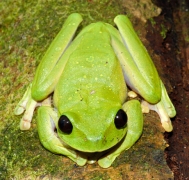 Much of PNG's forests remain unexplored, and have been kept in pristine condition thanks to the care of the local tribes who inhabit them.
Much of PNG's forests remain unexplored, and have been kept in pristine condition thanks to the care of the local tribes who inhabit them.
"Their intimate knowledge of and stewardship over a large tract of this vast upland wilderness has led to conservation of their wildlife and environment," said Bruce Beehler from Conservation International.
The tribes rely on the wilderness for hunting as well as gathering forest products, and the region provides fresh drinking water to thousands of people living in the Enga Southern Highlands as well as Western and Saudaun provinces.
Click on the frog image to see other photos on National Geographic website and read about those species. Uniquely adapted to their habitat, females lay their eggs underneath river stones, and tadpoles have mouths that can suction onto slippery rocks.
Other new species include jumping spiders, a striped gecko, and a tiny chirping frog. More than 600 species, old and new, were documented during the expedition into the vast Kaijende uplands, one of the Papua New Guinea's largest mountainous wilderness areas. The forests also are significantly critical as they absorb large amounts of the greenhouse gas carbon dioxide, and this absorbsion helps with slowing global warming.
However, deforestation has been occuring and is reported in this National Geographical story. Satellite images from 1998 and 2008 depict this clearly and according to a study of three decades of satellite imagery 8 million hectares of forest were lost between 1972 and 2002.